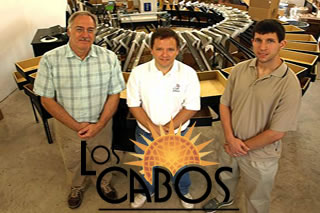
"Pitch pairing is something we've wanted to do for a few years now. Since we first started turning sticks, our sorting and printing was done completely by hand. As our manufacturing began to increase, so did our need to improve the post-production side of things. Now we can take our overall quality one step further."
The design and production of this unique machine was spearheaded by UNB�s Jason Elliot and supervised by Dr. Juan Carretero, director of the school's Robotics and Mechanisms Laboratory.
Company president Larry Guay worked closely with the university engineers to ensure the design and operation of the project would meet the needs of his growing company. Larry says:
"I think it was a great project for both the University of New Brunswick and Los Cabos Drumsticks. We gave a young engineer the opportunity to design and build a rather complicated machine. He gained real-world design and work experience in his field and we got a great machine."
The Spider takes each finished drumstick through four stages of the post-production process. First, a stick is weighed by a computer scale which then registers the unique pitch of each stick. Sticks are then printed by a pad-printing machine before being picked up by a robot arm that sorts each individual stick based on its weight and pitch properties. Sticks are then colour-matched and sleeved by hand, an important process that allows for one final inspection before shipping. Larry:
"Since The Spider was introduced to our operation, I've been wondering how we managed to get by without it for so long. This machine is amazing. It has definitely helped our company grow to another level."
© Drummerszone.com 2002-2025 Drummerszone.com is a Musicpublishers.nl website.
Oops, you're not logged in!
The more you like
the more you get!
